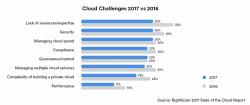Why Is Hybrid Cloud Emerging as the Dominant Deployment Model?
Why Cloud?
Let us count the ways.
- Cloud brings a new model to IT, one based on the delivery of services rather than the delivery of technology. With cloud computing as the foundation for IT modernisation, organisations can reduce capital expenditures, lower total cost of ownership, improve productivity, accelerate time to market, mitigate the risk of downtime, reduce IT complexity and use IT personnel far more strategically.
- It enables organisations to leverage benefits such as resource pooling, elastic scalability and self-service provisioning to increase agility and improve responsiveness to customer needs.
- Cloud provides a much more efficient technology platform for the critical IT initiatives of the modern era, such as big data analytics, social networking, mobile applications and the Internet of Things.
- It lowers risk and increases agility by introducing a highly automated approach to IT, with a simplified model for integrating a wide range of applications through application programming interfaces (APIs).
But wait, there’s more.
In addition, cloud enables organisations to improve the performance and availability of business-critical workloads, including databases, online transaction processing systems, customer relationship management, human resources, finance and others. By migrating these applications to the cloud, IT can modernise their underlying infrastructure, making it much faster and easier to add new features and services to support important trends such as mobility.

Why now?
The digital transformation.
Aging legacy infrastructures with siloed data and applications are an impediment to progress, competitiveness and innovation. At the same time, companies must respond to the realities of a rapidly changing work environment driven by digital transformation. By the end of the decade, digital transformation will “reshape the global economy,” according to IDC, with nearly 75% of overall IT spending going toward technologies, including cloud, that support these initiatives1.
Organisations can’t afford to be left behind. Digital transformation has disrupted entire industries: Uber in transportation and Airbnb in travel are two widely cited examples. But organisations in government, healthcare, financial services, education, retail, manufacturing and other industries are just as susceptible to shifting business models and therefore must have an agile IT infrastructure that can react quickly to changing market conditions.
New Expectations.
Another important aspect of digital transformation is the changing nature of workforces and customers. We are living in a world where mobility is increasingly important and a new generation of workers and customers has a new set of expectations. This change is often expressed as “IT consumerisation,” whereby users take their experiences and expectations from the consumer world
and apply them to the business world. It means IT teams must deliver accelerated application development cycles, mobile-native applications, and new user and customer experiences through distributed services and multi-platform content generation.
Why a hybrid cloud deployment model?
Challenge 1 – Managing the Public Cloud
For many companies, initial experience with the cloud is through the use of public cloud services. Australia has one of the highest adoption rates of cloud computing in the Asia-Pacific region, with more than 80% of local organisations using cloud services2. The public cloud services market in Australia exceeded $4.25 billion USD by 2017. On average, midsize and large organisations in Australia are using 370 cloud applications each, based on Microsoft’s research of companies that have at least 250 PCs3.

However, companies in Australia are also discovering that they are experiencing many of the same challenges as other companies across the globe in relying strictly on public cloud services.
These challenges include:
- Cost overruns
Most companies don’t have the inhouse expertise or resources to understand and control the costs of public cloud services. According to RightScale’s “2017 State of the Cloud Report,” IT professionals estimate that 30% of their cloud expenditures are wasted. As if that figure weren’t high enough, the research concludes that the actual waste number is somewhere between 30% and 45%4.
- Security protections
Although concerns about security are declining as companies become more comfortable with cloud services, the reality is that security remains one of the top issues for organisations in using public cloud. According to the “2017 State of the Cloud Report,” security was cited by 25% of IT professionals as one of their top concerns5.
- Lack of resources and expertise
IT leaders also continue to be troubled by their inability to find and retain in-house professionals with the experience and skills to manage complex cloud environments. RightScale’s research found lack of resources and expertise and managing cloud were top concerns for 25% of IT professionals6. In Australia, the skills gap is particularly pronounced: Nearly 65% of respondents to the Microsoft survey said they lack skills in security and 50% cited a skills gap in cloud app management7.

Challenge 2 – Dealing with Ageing, Expensive IT Legacy
So, on the one hand, organisations have these very critical challenges—costs, security, and lack of resources and expertise—in utilising public cloud services on their own.
On the other hand, they also face enormous challenges in keeping the status quo with their on-premise data centres. Many organisations are dealing with aging IT legacy infrastructures that must be upgraded to meet the changing demands of today’s business environment.
Siloed approaches, with isolated data and applications and separate teams for compute, storage and networking, are unwieldly in the cloud era—where speed, agility and mobility are necessary to remain competitive.
Among the challenges with ageing IT infrastructure:
- Performance
To meet today’s performance requirements with on-premises data centres, most organisations need to modernise their infrastructure, which means investing in more powerful servers, flash storage, software-defined architectures, network fabrics, hyper-converged infrastructures—the list goes on. And, of course, as new technology becomes available, the upgrade cycle begins all over again.
- Costs
The Capex investment required to make these upgrades can be enormous at a time when IT budgets are not necessarily growing. Beyond the upfront costs, the operational expenses in maintaining, managing, upgrading, powering, cooling and housing on-premises infrastructure continue to rise, as do the costs of hiring and retaining trained personnel for these functions— if, indeed, you can even find people with the skills needed.
- Complexity
As you try to leverage the value of data across the organisation, information and application silos become a significant impediment. So do separate silos for compute, storage and networking. Factor in the additional layer of managing cloud services— remember, the average midsize or large organisation is using 370 cloud apps—and complexity becomes a huge issue, particularly in ensuring availability, security, compliance and uptime over an increasingly dispersed and diffused environment.

The Solution: Hybrid Cloud and Hybrid IT
A Hybrid Cloud deployment model provides an elegant solution to the challenges associated with managing public cloud services and upgrading/migrating legacy IT investments. IT can exert greater control over which applications and workloads are deployed in the cloud and which are hosted on premise, at a colocation facility or in a managed private cloud. This is also often described as a hybrid IT model, whereby cloud and physical hardware environments are mixed to address different business needs.
More than just flexibility
The hybrid IT model offers a flexible approach to leveraging existing infrastructure investment and modernising where needed. Certain workloads can remain with on-premise infrastructure, while others can migrate to the public cloud or a private cloud service. You can move workloads on an as needed basis, extending the lifecycle of existing equipment. When equipment needs to be upgraded or modernised, you have the flexibility to move additional applications and workloads to the cloud rather than make another capital investment. In addition to flexibility, hybrid cloud and hybrid IT models offer a wide range of advantages, including (but not limited to):
- Control
Many business and IT leaders are still wary about using public cloud because of concerns about security, data sovereignty, regulatory compliance and availability. In some industries, data protection and compliance requirements limit the ability to use cloud services at all. Hybrid cloud gives IT greater control over these critical areas to minimise risk. With hybrid cloud, IT can also exert more control of shadow IT by offering lineof- business managers company-approved services to address their needs.
- Affordability
With hybrid cloud, IT can leverage the same economies of scale as with a public cloud, paying for resources when they are needed. In addition, IT can continue to optimise existing infrastructure investments or take advantage of cost-effective alternatives such as colocated data centres, virtual data centres, managed hosting, PaaS, IaaS or private cloud as a service.
The hybrid IT model offers a flexible approach to leveraging existing infrastructure investment and modernising where needed.
- Reliability
If existing infrastructure is delivering the reliability, performance and uptime you require for business-critical applications, you can continue to leverage it for those applications. The new reality, however, is that cloud services are often more reliable than on-premises solutions, so you can feel safe when moving key apps into the cloud. With a cloud service provider, you can get uptime guarantees of as much as 99.99% or more.
- Scalability
Hybrid cloud models offer simple and almost limitless scalability. This will make your business more agile, enabling you to deliver the right resources to the right applications at the right time. For example, if there are certain times of the year when there are spikes in the business, you can use public cloud to supplement existing resources. Likewise, you can empower DevOps teams to succeed by removing the complexity of managing infrastructure, particularly if you can also leverage the strengths of a managed services provider to eliminate or minimise the complexity of managing the hybrid cloud.
- Security
One of the myths about the cloud is that it is less secure than on-premise solutions. There are additional security considerations when using the cloud—for example, your data can be instantly exposed to the Internet if access control lists are not properly imposed. But there are ways to mitigate those risks, particularly if you rely on a single provider to manage your hybrid cloud deployment. In addition, cloud providers tend to be more proactive in managing security risks than most businesses. They are typically more knowledgeable about today’s security challenges and more current in deploying the latest security technologies.
- Business continuity
Availability is more important than ever in today’s highly digitised environment. One study estimates that the average cost of downtime for organisations of 1,000 or more employees is $16 million a year.11 Hybrid cloud can enable a low-cost disaster recovery function, while also leveraging cloud services to support faster and more efficient backups. With hybrid cloud, IT can maintain production systems on premise or in a private cloud with real-time replication and failover capabilities into the public cloud.
This article is an excerpt from a white-paper designed to help IT and business leaders understand the exciting opportunities enabled by a successful migration to the cloud, particularly the hybrid cloud. Click on the button below to download your free copy.
[2] “Australia Country Commercial Guide, Australia – Cloud Computing,” Export. gov, Sept. 23, 2016
[3] Ibid. footnote 2
[4] “2017 State of the Cloud Report,” RightScale, Feb. 15, 2017
[5] Ibid. footnote 4
[6] Ibid. footnote 4
[7] “Microsoft Survey: IT Leaders in Australia are Prioritising Hybrid Cloud to Transform IT,” Microsoft, Nov. 10, 2016


